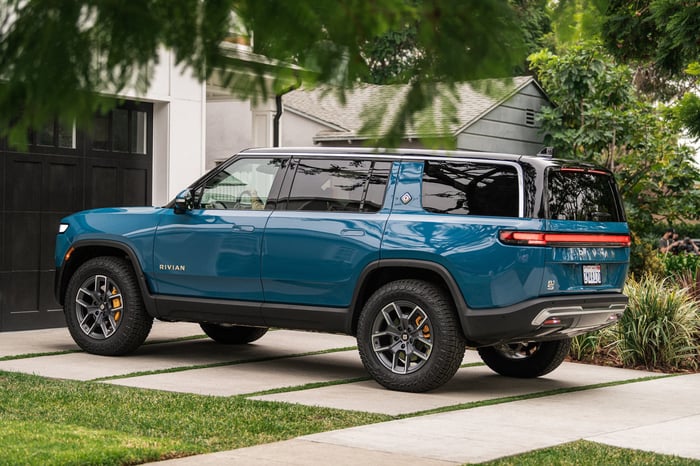The stock of e-commerce titan Amazon (AMZN -1.65%) sank 14% the day after reporting its results for the first quarter of 2022. The company performed well, particularly in the Amazon Web Services (AWS) segment, but there was a notable drag on its profitability.
In October 2021, Amazon disclosed that it held a 20% stake in electric vehicle (EV) maker Rivian Automotive (RIVN -3.62%), which debuted on the market the following month. The stock rapidly rose in value, which dealt Amazon a significant gain into the end of the year. But Rivian's stock has since collapsed, disrupting an otherwise healthy start to 2022 for Amazon's overall business.

Image source: Rivian Automotive.
A long-standing partnership
The relationship between Amazon and Rivian dates back to 2019 when Amazon bought into the EV maker, leading a $700 million funding round. Amazon placed an order for 100,000 electric vehicles to refresh its delivery fleet, and it considers Rivian a crucial part of its plan to convert all of its combustion engine-powered company vehicles to renewable alternatives by 2030.
While Rivian only produced 1,015 cars in 2021, its IPO was met with enthusiasm, which sent its stock soaring 129% to an all-time high of $179. The gain was short-lived, but Rivian stock maintained enough buoyancy to add $11.8 billion to Amazon's net income for Q4 2021.

However the stock has since collapsed to just $32 per share, heavily weighing on Amazon's Q1 2022 results. It triggered Amazon's first quarterly loss since 2015.
The electric vehicle industry is becoming increasingly crowded, with every manufacturer chasing Tesla, which leads the pack by a very wide margin. Rivian does have the benefit of 183,000 preorders for its vehicles, and it's focused on building toward an annual manufacturing capacity of 600,000 units.
With the support of $1.2 trillion giant Amazon, it has a solid chance to grow into a success, which would reverse the negative impact on Amazon's bottom line over the long run.
An otherwise solid quarter
Amazon's business is diverse and while e-commerce is its flagship, the company is also a leader in cloud services via the AWS platform. It also began to report results under its fast-growing advertising segment at the end of 2021, and the positive impact has continued to flow into 2022 with 23% year-over-year growth.

Amazon hasn't shared anything beyond revenue figures for the advertising segment, so it could be some time before investors get visibility into the profitability
But for now, AWS is the engine powering the company's bottom line. In Q1 2022, it generated $6.5 billion in operating income, a whopping 56% increase from Q1 2021.It was the bright spot across the whole business with e-commerce making a $2.8 billion operating loss, and Rivian dragging the difference firmly into the red.
Amazon's total revenue for Q1 2022 was $116 billion, a modest 7% increase year over year. It was weighed down by factors like the geopolitical tensions in Europe and the gradual slowdown of the pandemic's effects on online shopping compared to the use of physical stores. Inflation and supply chain challenges also contributed to downward pressure.
Still, between cloud computing and advertising, there were enough bright spots to make any dip in stock price from this report worth buying, especially considering the company's long-term prospects. And if Rivian can turn its stock prospects around, buying Amazon stock at this price would be a smart move for investors who want a bit of exposure to an EV newcomer.





